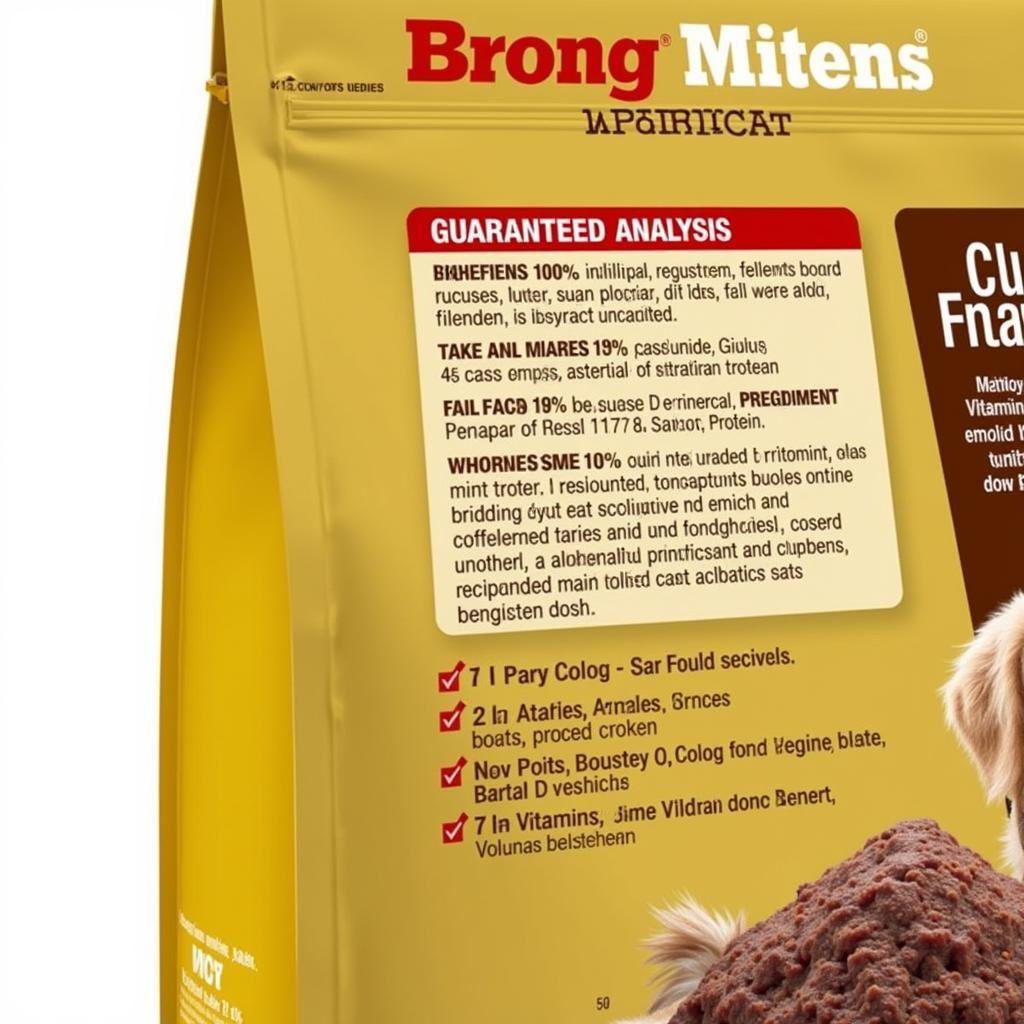Dog Food Prime might sound like a fancy marketing term, but it’s actually about prioritizing the best nutrition for your furry friend. Just like humans, dogs thrive on a balanced diet that supports their overall health and well-being.
Understanding your dog’s nutritional needs is key to selecting the right dog food. Factors like breed, age, activity level, and any existing health conditions play a significant role in determining the optimal dietary choices.
Decoding Dog Food Labels: A Guide to Prime Nutrition
Navigating the world of dog food labels can feel like deciphering a foreign language. However, arming yourself with the right knowledge empowers you to make informed decisions for your canine companion.
-
Ingredient List: This is your first clue to the quality of the dog food. Look for whole food sources like meat, poultry, or fish listed as the primary ingredients. Avoid foods with excessive fillers like corn, wheat, and soy, as these offer minimal nutritional value.
-
Guaranteed Analysis: This section outlines the minimum percentages of crucial nutrients, including protein, fat, fiber, and moisture. A higher protein content is generally desirable, especially for active dogs.
-
Life Stage: Dog food formulas are tailored to specific life stages: puppy, adult, senior. Each stage has unique nutritional requirements. For instance, puppies require higher calorie and protein content to support their rapid growth.
-
AAFCO Statement: The Association of American Feed Control Officials (AAFCO) sets nutritional standards for pet food. A product that meets AAFCO guidelines ensures balanced nutrition for your dog.
 Dog Food Label Analysis
Dog Food Label Analysis
Beyond the Basics: Tailoring Dog Food Prime to Your Dog’s Needs
While understanding dog food labels is essential, selecting the best dog food prime goes beyond simply checking the boxes. Consider these additional factors:
-
Breed Size: Large breed dogs have different dietary needs compared to their smaller counterparts. Large breed puppy food, for instance, often contains controlled levels of calcium and phosphorus to promote healthy bone development.
-
Activity Level: A highly active dog, like a working breed or a sporting companion, needs a higher calorie diet to fuel their energy levels. Conversely, less active dogs might require a lower calorie formula to prevent weight gain.
-
Health Considerations: Just like humans, dogs can experience food allergies or sensitivities. If your dog has specific health issues, consult with your veterinarian to identify the most suitable dietary choices. They might recommend special formulas for sensitive stomachs, skin allergies, or joint health.
Making the Switch: Transitioning to a New Dog Food Prime
Once you’ve carefully chosen the best dog food prime for your furry friend, it’s important to transition gradually. Abruptly changing your dog’s food can lead to digestive upset.
-
Gradual Introduction: Start by mixing a small amount of the new food with your dog’s current food. Gradually increase the ratio of new food over 7-10 days.
-
Monitor for Changes: Observe your dog closely during the transition period. Look for any signs of digestive issues, like vomiting, diarrhea, or loss of appetite. If you notice any adverse reactions, consult with your veterinarian.
Dog Food Prime: Investing in a Lifetime of Health
Choosing the best dog food prime is an investment in your canine companion’s long-term health and happiness. By understanding your dog’s nutritional needs and becoming a savvy label reader, you can provide them with the foundation for a vibrant and fulfilling life. Remember, a healthy dog is a happy dog, and their nutrition plays a crucial role in their overall well-being.
 Happy Dog Enjoying Premium Food
Happy Dog Enjoying Premium Food
FAQs:
1. What is the difference between “dog food prime” and regular dog food?
“Dog food prime” emphasizes prioritizing the best quality ingredients and nutritional value for your dog. It encourages focusing on factors beyond basic dietary needs, such as breed size, activity level, and health considerations.
2. How can I tell if my dog has a food allergy?
Common signs of food allergies in dogs include itchy skin, excessive scratching, gastrointestinal upset (vomiting, diarrhea), ear infections, and hair loss. If you suspect your dog has a food allergy, consult with your veterinarian for diagnosis and treatment options.
3. How often should I change my dog’s food?
Once you’ve found a high-quality dog food prime that agrees with your dog, there’s generally no need for frequent changes. However, adjustments might be necessary as your dog transitions through different life stages (puppy, adult, senior).
4. Is grain-free dog food better for my dog?
Not necessarily. While some dogs might benefit from a grain-free diet, particularly those with grain allergies or sensitivities, most dogs can digest grains without any issues. Consult with your veterinarian to determine if a grain-free diet is appropriate for your dog.
5. Can I supplement my dog’s diet with homemade food?
While it can be tempting to supplement your dog’s diet with homemade treats or meals, it’s essential to ensure these additions are nutritionally balanced and safe. Consult with your veterinarian or a veterinary nutritionist for guidance on safe and healthy homemade recipes for your dog.
Need more help?
Explore these other articles on our website:
- “Table top food steamer” for preparing healthy and delicious meals for your furry friend.
- “Fish food with high protein” if you’re looking for alternative protein sources for your dog.
Don’t hesitate to contact us for personalized advice. Call us at 02437655121, email us at [email protected], or visit us at 3PGH+8R9, ĐT70A, thôn Trung, Bắc Từ Liêm, Hà Nội, Việt Nam. Our dedicated customer support team is available 24/7 to answer your queries.